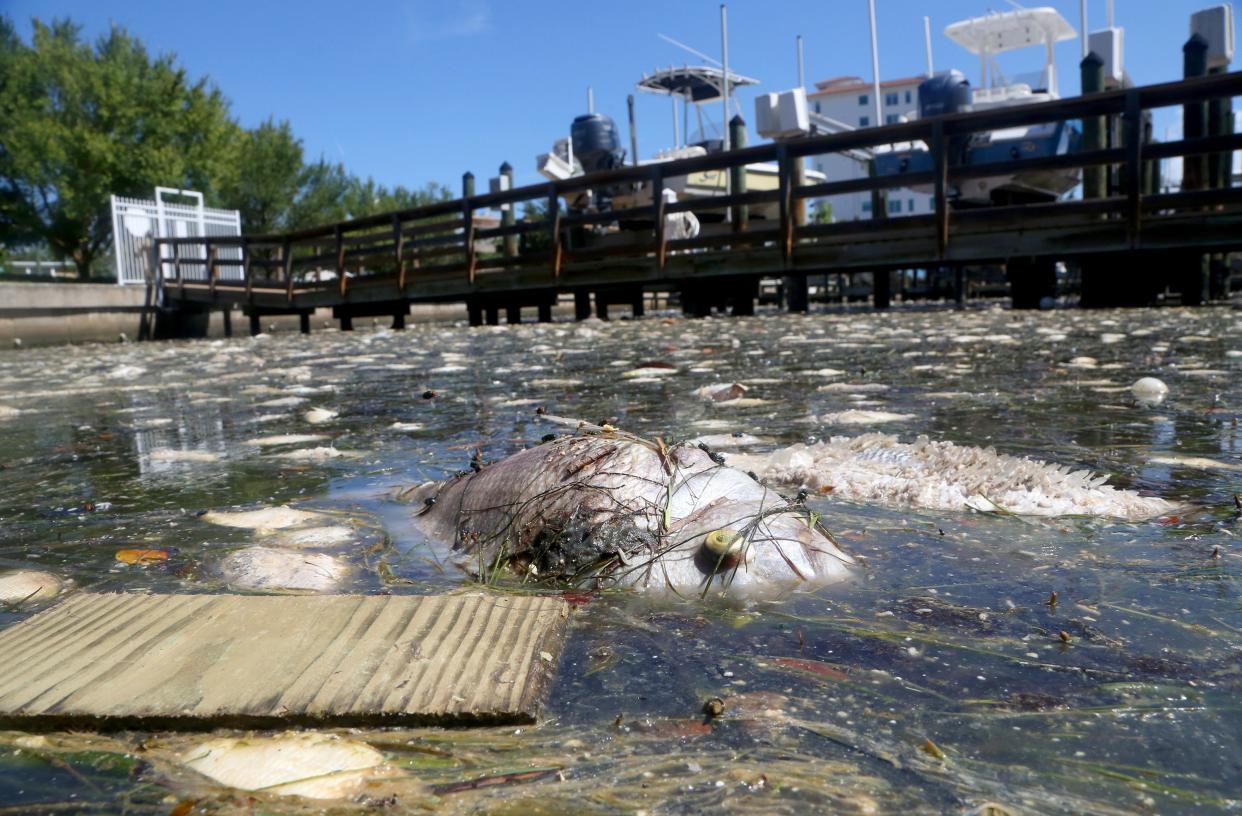Environmentalists urge DeSantis to declare Red Tide emergency

- Oops!Something went wrong.Please try again later.
ST. PETERSBURG — More than two dozen environmental organizations joined calls for Gov. Ron DeSantis to declare a state of emergency for the Tampa Bay area as Red Tide continues to leave dead fish along the coast and disrupt business across the region.
An executive order would help organize and finance Red Tide clean-up efforts, said a letter signed by 29 organizations and organized by the Center for Biological Diversity. The Ocean Conservancy sent a letter saying a statewide effort, rather than local governments scrambling to deal with the disaster, would help mitigate the catastrophe.
“This is the whole job of having a centralized executive government,” said Jaclyn Lopez, Florida Director and senior attorney for the Center for Biological Diversity. “To provide this type of oversight and leadership, when there’s a crisis of regional magnitude, which is what Red Tide is.”
Lopez said the order would also: bring state oversight to cleanup efforts, make more state funding sources available and allow for a regional strategy to deal with the economic and environmental fallout. The state had sent nearly $1 million to help local cleanup efforts in St. Petersburg and Pinellas County as of last week.
“What we really need here is the freeing up of resources to actually get on the water and clean up the dead fish that are already in the water,” said J.P. Brooker, director of Florida conservation at the Ocean Conservancy. “As those fish decay, they’re going to release more nitrogen, which is going to fuel the Red Tide event even further.”
The letters add to the chorus of voices calling for the governor to act. Last week St. Petersburg Mayor Rick Kriseman asked for an emergency order and received a sharp rebuke from DeSantis’ office, which said the state was already helping and accused Kriseman of trying to score “cheap political points.”
The St. Petersburg City Council passed a resolution the following night asking DeSantis to declare a state of emergency. Florida Agriculture Commissioner Nikki Fried, who will run for the Democratic nomination for governor in 2022, issued a similar call.
DeSantis briefly addressed Red Tide during a news conference Monday in Poinciana to celebrate the passage of a land conservation bill. At the ceremonial signing, he spoke first about unrest in Cuba and then U.S. immigration policy, including his weekend trip to the Texas border, before a reporter asked about Red Tide. The governor reiterated that his administration is tapping a dedicated fund to support the local response to the toxic bloom.
“We have that pot of money,” DeSanits said. “We’re using it.”
He added: “Unfortunately this thing doesn’t just leave so we’re going to have to deal with this.”
Meanwhile Red Tide toxins continue to take an ecological toll: Pinellas County says it has collected a total of more than 1,277 tons of dead marine life and debris. By comparison, the county picked up about 1,800 tons during the 2018 outbreak that affected Pinellas’ coast.
Nearly 300 tons of waste were recovered Friday and Saturday alone, said county spokesman Tony Fabrizio, and workers reported picking up three dead loggerhead turtles as well as a dead dolphin in recent days. The county had about 30 boats out picking the dead from the water Monday.
The beaches are beginning to see more debris as stronger Red Tide concentrations show up there. Crews circled from Weedon Island to Tierra Verde over the weekend. Fabrizio said beaches up to Indian Shores have seen dead fish.
A flight over the coast showed “extremely discolored water” and dead fish offshore from Blind Pass to Indian Shores, he said. Discolored water is also lingering in Tampa Bay, though officials hope rain will introduce more freshwater to the estuary, which could help alleviate the situation.
Environmental organizations blame the Piney Point disaster, when in April the state allowed 215 million gallons of polluted water from an old Manatee County fertilizer plant to be released into the bay so that it wouldn’t spill into neighborhoods. That likely is providing fuel for the Red Tide bloom.
“If the continued insults from water pollution are not addressed, our marine ecosystems and the economy built around them will fail,” said a statement from Shawn Martin, chair of Surfrider Florida Foundation Florida Keys chapter.
Red Tide resources
These online resources will keep you informed and safe:
The Florida Fish and Wildlife Conservation Commission has a website that tracks where Red Tide is detected.
Florida Poison Control Centers have a toll-free 24/7 hotline to report illnesses, including from exposure to Red Tide: 1-800-222-1222
To report dead fish for clean-up in Tampa Bay, call the Florida Fish and Wildlife Conservation Commission at 1-800-636-0511 or file a fish kill report online.
In St. Petersburg, call the Mayor’s Action Center at 727-893-7111 or use St. Petersburg’s seeclickfix website.
Visit St. Pete/Clearwater, the county’s tourism wing, runs an online beach dashboard at www.beachesupdate.com.
The Red Tide Respiratory Forecast allows beachgoers to check for warnings.
How to stay safe near the water
Do not swim around dead fish.
Those with chronic respiratory problems should be careful and stay away from places with a Red Tide bloom. Leave if you think Red Tide is affecting you.
Do not harvest or eat mollusks or distressed and dead fish from the area. Fillets of healthy fish should be rinsed with clean water, and the guts thrown out.
Pet owners should keep their animals away from the water and from dead fish.
Residents living near the beach should close their windows and run air conditioners with proper filters.
Beachgoers can protect themselves by wearing masks.
Source: Florida Department of Health in Pinellas County

